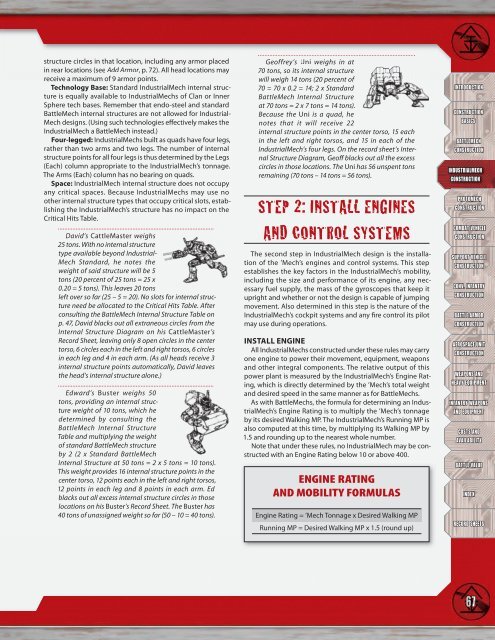the shape of things to come
the shape of things to come
the shape of things to come
Create successful ePaper yourself
Turn your PDF publications into a flip-book with our unique Google optimized e-Paper software.
structure circles in that location, including any armor placed<br />
in rear locations (see Add Armor, p. 72). All head locations may<br />
receive a maximum <strong>of</strong> 9 armor points.<br />
Technology Base: Standard IndustrialMech internal structure<br />
is equally available <strong>to</strong> IndustrialMechs <strong>of</strong> Clan or Inner<br />
Sphere tech bases. Remember that endo-steel and standard<br />
BattleMech internal structures are not allowed for Industrial-<br />
Mech designs. (Using such technologies eff ectively makes <strong>the</strong><br />
IndustrialMech a BattleMech instead.)<br />
Four-legged: IndustrialMechs built as quads have four legs,<br />
ra<strong>the</strong>r than two arms and two legs. The number <strong>of</strong> internal<br />
structure points for all four legs is thus determined by <strong>the</strong> Legs<br />
(Each) column appropriate <strong>to</strong> <strong>the</strong> IndustrialMech’s <strong>to</strong>nnage.<br />
The Arms (Each) column has no bearing on quads.<br />
Space: IndustrialMech internal structure does not occupy<br />
any critical spaces. Because IndustrialMechs may use no<br />
o<strong>the</strong>r internal structure types that occupy critical slots, establishing<br />
<strong>the</strong> IndustrialMech’s structure has no impact on <strong>the</strong><br />
Critical Hits Table.<br />
David’s CattleMaster weighs<br />
25 <strong>to</strong>ns. With no internal structure<br />
type available beyond Industrial-<br />
Mech Standard, he notes <strong>the</strong><br />
weight <strong>of</strong> said structure will be 5<br />
<strong>to</strong>ns (20 percent <strong>of</strong> 25 <strong>to</strong>ns = 25 x<br />
0.20 = 5 <strong>to</strong>ns). This leaves 20 <strong>to</strong>ns<br />
left over so far (25 – 5 = 20). No slots for internal structure<br />
need be allocated <strong>to</strong> <strong>the</strong> Critical Hits Table. After<br />
consulting <strong>the</strong> BattleMech Internal Structure Table on<br />
p. 47, David blacks out all extraneous circles from <strong>the</strong><br />
Internal Structure Diagram on his CattleMaster’s<br />
Record Sheet, leaving only 8 open circles in <strong>the</strong> center<br />
<strong>to</strong>rso, 6 circles each in <strong>the</strong> left and right <strong>to</strong>rsos, 6 circles<br />
in each leg and 4 in each arm. (As all heads receive 3<br />
internal structure points au<strong>to</strong>matically, David leaves<br />
<strong>the</strong> head’s internal structure alone.)<br />
Edward’s Buster weighs 50<br />
<strong>to</strong>ns, providing an internal structure<br />
weight <strong>of</strong> 10 <strong>to</strong>ns, which he<br />
determined by consulting <strong>the</strong><br />
BattleMech Internal Structure<br />
Table and multiplying <strong>the</strong> weight<br />
<strong>of</strong> standard BattleMech structure<br />
by 2 (2 x Standard BattleMech<br />
Internal Structure at 50 <strong>to</strong>ns = 2 x 5 <strong>to</strong>ns = 10 <strong>to</strong>ns).<br />
This weight provides 16 internal structure points in <strong>the</strong><br />
center <strong>to</strong>rso, 12 points each in <strong>the</strong> left and right <strong>to</strong>rsos,<br />
12 points in each leg and 8 points in each arm. Ed<br />
blacks out all excess internal structure circles in those<br />
locations on his Buster’s Record Sheet. The Buster has<br />
40 <strong>to</strong>ns <strong>of</strong> unassigned weight so far (50 – 10 = 40 <strong>to</strong>ns).<br />
Ge<strong>of</strong>frey’s Uni weighs in at<br />
70 <strong>to</strong>ns, so its internal structure<br />
will weigh 14 <strong>to</strong>ns (20 percent <strong>of</strong><br />
70 = 70 x 0.2 = 14; 2 x Standard<br />
BattleMech Internal Structure<br />
at 70 <strong>to</strong>ns = 2 x 7 <strong>to</strong>ns = 14 <strong>to</strong>ns).<br />
Because <strong>the</strong> Uni is a quad, he<br />
notes that it will receive 22<br />
internal structure points in <strong>the</strong> center <strong>to</strong>rso, 15 each<br />
in <strong>the</strong> left and right <strong>to</strong>rsos, and 15 in each <strong>of</strong> <strong>the</strong><br />
IndustrialMech’s four legs. On <strong>the</strong> record sheet’s Internal<br />
Structure Diagram, Ge<strong>of</strong>f blacks out all <strong>the</strong> excess<br />
circles in those locations. The Uni has 56 unspent <strong>to</strong>ns<br />
remaining (70 <strong>to</strong>ns – 14 <strong>to</strong>ns = 56 <strong>to</strong>ns).<br />
STEP 2: INSTALL ENGINES<br />
AND CONTROL SYSTEMS<br />
The second step in IndustrialMech design is <strong>the</strong> installation<br />
<strong>of</strong> <strong>the</strong> ’Mech’s engines and control systems. This step<br />
establishes <strong>the</strong> key fac<strong>to</strong>rs in <strong>the</strong> IndustrialMech’s mobility,<br />
including <strong>the</strong> size and performance <strong>of</strong> its engine, any necessary<br />
fuel supply, <strong>the</strong> mass <strong>of</strong> <strong>the</strong> gyroscopes that keep it<br />
upright and whe<strong>the</strong>r or not <strong>the</strong> design is capable <strong>of</strong> jumping<br />
movement. Also determined in this step is <strong>the</strong> nature <strong>of</strong> <strong>the</strong><br />
IndustrialMech’s cockpit systems and any fi re control its pilot<br />
may use during operations.<br />
INSTALL ENGINE<br />
All IndustrialMechs constructed under <strong>the</strong>se rules may carry<br />
one engine <strong>to</strong> power <strong>the</strong>ir movement, equipment, weapons<br />
and o<strong>the</strong>r integral components. The relative output <strong>of</strong> this<br />
power plant is measured by <strong>the</strong> IndustrialMech’s Engine Rating,<br />
which is directly determined by <strong>the</strong> ’Mech’s <strong>to</strong>tal weight<br />
and desired speed in <strong>the</strong> same manner as for BattleMechs.<br />
As with BattleMechs, <strong>the</strong> formula for determining an IndustrialMech’s<br />
Engine Rating is <strong>to</strong> multiply <strong>the</strong> ’Mech’s <strong>to</strong>nnage<br />
by its desired Walking MP. The IndustrialMech’s Running MP is<br />
also computed at this time, by multiplying its Walking MP by<br />
1.5 and rounding up <strong>to</strong> <strong>the</strong> nearest whole number.<br />
Note that under <strong>the</strong>se rules, no IndustrialMech may be constructed<br />
with an Engine Rating below 10 or above 400.<br />
ENGINE RATING<br />
AND MOBILITY FORMULAS<br />
Engine Rating = ’Mech Tonnage x Desired Walking MP<br />
Running MP = Desired Walking MP x 1.5 (round up)<br />
INTRODUCTION<br />
CONSTRUCTION<br />
BASICS<br />
BATTLEMECH<br />
CONSTRUCTION<br />
INDUSTRIALMECH<br />
CONSTRUCTION<br />
PROTOMECH<br />
CONSTRUCTION<br />
COMBAT VEHICLE<br />
CONSTRUCTION<br />
SUPPORT VEHICLE<br />
CONSTRUCTION<br />
CONV. INFANTRY<br />
CONSTRUCTION<br />
BATTLE ARMOR<br />
CONSTRUCTION<br />
AEROSPACE UNIT<br />
CONSTRUCTION<br />
WEAPONS AND<br />
HEAVY EQUIPMENT<br />
INFANTRY WEAPONS<br />
AND EQUIPMENT<br />
COSTS AND<br />
AVAILABILITY<br />
BATTLE VALUE<br />
INDEX<br />
RECORD SHEETS<br />
67


